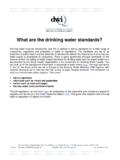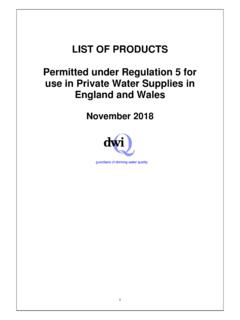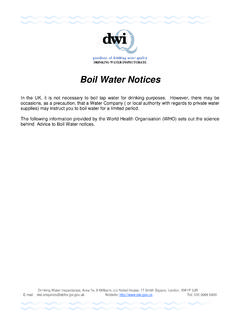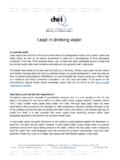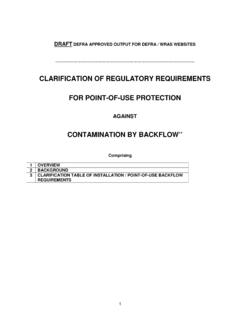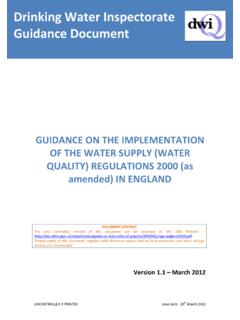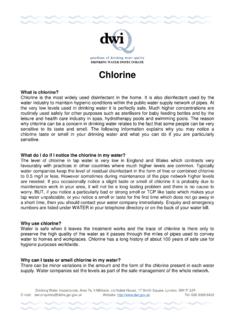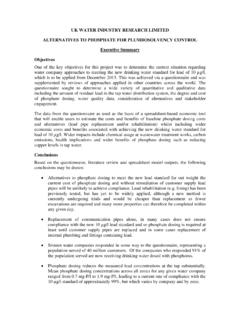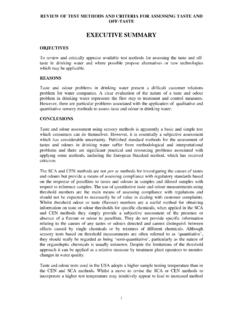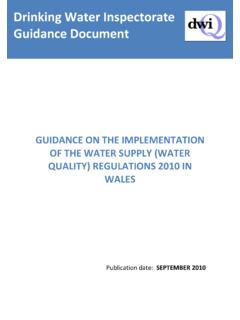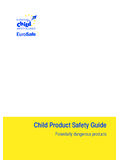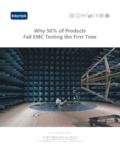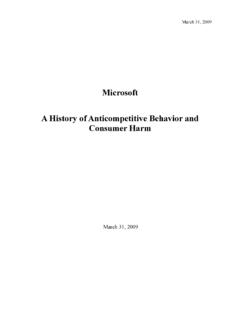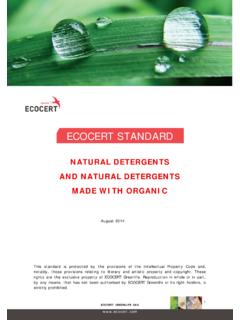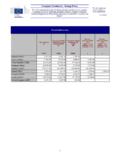Transcription of WHAT IS THE PROGRESS WITH EUROPEAN …
1 WHAT IS THE PROGRESS WITH EUROPEAN TESTING AND approval OF drinking water construction PRODUCTS? 1. BACKGROUND The Regulatory Group - construction Products drinking water (RG-CPDW), which was established by DG Enterprise and reported to the Standing Committee on construction , developed a proposal for a comprehensive EUROPEAN Acceptance Scheme (EAS) for construction products used with water intended for human consumption ( drinking water ). It was originally envisaged that this global EAS would replace existing national regulatory schemes for ensuring, through testing, that products used with drinking water would conform to the requirements of Article 10 (Quality assurance of treatment, equipment and materials) of the drinking water Directive (DWD)1. The original aim of the global EAS was that products tested and accepted under the EAS in one Member State (MS) would be eligible for use in any MS of the EUROPEAN Economic Area (EEA). More recently a new group, the Expert Group - construction Products drinking water (EG-CPDW) was established by the Commission to advise on the development of a CPD-EAS based on construction products as defined by the construction Products Directive (CPD)2 and used with treated water between the last point of treatment and the consumer's tap.
2 Thus this CPD-EAS would not have fully conformed with the requirements of Article 10 of the DWD because it would have excluded construction products used in the collection or abstraction of water and up to and including the last point of treatment of drinking water supplies. In October 2007 a Group, consisting of the drinking water Regulators for France, Germany, the Netherlands and the UK (4 MSR), together with the CEN Rapporteur, was set up in response to a series of questions from the Commission DG Enterprise. They have concentrated on the possible harmonisation of their own, well established, schemes for the approval of products in contact with drinking water . They issued a Report to the Commission, CEN and other interested bodies in April 2008. The following documents are available on our website see Section 6 of this FAQ for direct links a) A copy of this report b) The Annex II to this report this contains detailed comparative tables of existing approval schemes, plus a possible common proposal for future testing and approval processes.
3 (Note these tables have been subject to a continuing revision and elaboration process, and will ultimately include details of the requirements of other member states. Once this process is completed it is 1 Council Directive 98/83/EC on the quality of water intended for human consumption 2 Council Directive 89/106/EEC on the approximation of laws, regulations and administrative provision of the Member States relating to construction products approval OF PRODUCTS FOR USE WITH drinking water Regulation 31 Enquiries, Area 7e, 9 Millbank, c/o Nobel House, 17 Smith Square, London SW1P 3JR Tel: +44 (0) 300 068 6400 Email: Website: Frequently Asked Question 15 Version June 2016 Page 1 of 4 envisaged that the revised tables will become available for further scrutiny and development.) c) An introductory comment from the Inspectorate d) A commentary from the CEN Rapporteur. 2. TEST METHODS AND product STANDARDS Many drinking water treatment chemicals and inorganic supporting and filtering materials are now covered by relevant EN standards, and may not require further evaluation under the current relevant regulations3 - see Annexes and of the List of Approved Products ( ).
4 EUROPEAN Standards for some drinking water construction products have been published but these do not currently include detailed requirements for possible effects of the products on water quality, but rather refer to existing national requirements. A number of horizontal test methods for assessing the ability of organic and factory-made cementitious materials to effect water quality have now been published by CEN. In addition the first part of a series of standards covering the assessment of the effects of metallic products on water quality has now been published. Although this series of standards is currently incomplete, they currently cover many of the aspects of testing currently included in the test requirements of the established approval systems of France, Germany, the Netherlands and the UK. On-going work now needs to be completed for the methods for assessment to promote the growth of microorganisms, plus the GC-MS general survey to identify unsuspected compounds etc.
5 In addition work on test methods for metallic products is now proceeding, based upon the current requirements of Germany. 3. CLAIMS OF CONFORMITY WITH THE drinking water DIRECTIVE We are aware of manufacturers claiming that their products meet the requirements of the drinking water Directive (DWD). In reality fitness for use in contact with drinking water in terms of possible impacts on water quality, under the requirements of Article 10 of the DWD, cannot be determined until the development of the various test methods has been completed by CEN, and agreement has been reached on the acceptance procedures and test pass/fail requirements for the results from these tests. Thus any water undertaker considering the use of a product claimed to meet the requirements of the DWD, should note that the installation and use of such a product , unless the product has met the appropriate requirements of the relevant regulations3, would constitute an offence under the Regulations.
6 3 Regulation 31 of the water Supply ( water Quality) Regulations 2016 in England, Regulation 31 of the water supply ( water Quality) Regulations 2010 in Wales, Regulation 33 of the water Supply ( water Quality)(Scotland) Regulations 2014, and Regulation 30 of the water Supply ( water Quality)(Amendment) Regulations (Northern Ireland) 2009. Frequently Asked Question 15 Version June 2016 Page 2 of 4 4. PRODUCTS APPROVED FOR USE WITH drinking water IN OTHER MEMBER STATES AND REGULATION 31 Currently there is no agreement between ourselves and any other Member State (MS) on the mutual recognition of products approved under the various, differing, MS approval schemes, although results obtained during product evaluation in another MSs can be taken into account during the approval process for products under the requirements of the relevant regulations4. This latter comment applies also to product approved for use in the United States under the requirements of ANSI/NSF 61.
7 In the absence of harmonised product standards or EUROPEAN Technical Approvals for construction products, Regulation 31 requires that water companies use products conforming to: an appropriate British Standard a national standard of an EEA State that provides an equivalent level of protection and performance [Regulation 31(3)(b)] or use products that have been approved by the Secretary of State [Regulation 31(4)]. When water undertakers are considering use of products under Regulation 31(3)(b), they must obtain evidence to confirm that: a. the test requirements included assessments of potential adverse effects on water quality, including the ability of the non-metallic materials used in the product to promote the growth of aquatic microorganisms, an assessment of effects on the odour and flavour of both chlorine-free and chlorinated water , and an investigation into the leaching of any unsuspected compounds into water (GC-MS survey using both chlorine free and chlorinated test water ); and b.
8 The test conditions used represented the worst case conditions under which the product would be used as set out in the Instructions for Use; and c. the test parameters included those relevant to the product composition and relevant drinking water Directive parameters; and d. a toxicological assessment of the leaching test data was carried out. The drinking water Inspectorate (DWI) can advise applicants whether fully detailed test reports, submitted under "a" to "d", are acceptable providing the reports are available in English. 5. FUTURE DEVELOPMENTS Although DWI has taken steps to prepare for the possible future implementation of the revised CPD-EAS, including where appropriate and possible, early implementation of EUROPEAN standards for test methods for construction products, there are currently uncertainties concerning the extent to which the revised CPD-EAS could meet the product approval requirements and arrangements under Regulation 31 of the water Supply ( water Quality) Regulations (based upon Article 10 of DWD) and whether all the products currently approved under Regulation 31 will be covered by the revised CPD-EAS.
9 4 Regulation 31 of the water Supply ( water Quality) Regulations 2016 in England, Regulation 31 of the water supply ( water Quality) Regulations 2010 in Wales, Regulation 33 of the water Supply ( water Quality)(Scotland) Regulations 2014, and Regulation 30 of the water Supply ( water Quality)(Amendment) Regulations (Northern Ireland) 2009. Frequently Asked Question 15 Version June 2016 Page 3 of 4 In relation to the developments within the 4 MSR group (see 2 above), the Inspectorate remains committed to working with other Member State Regulators towards convergence of their existing approval systems test requirements. 6. FURTHER INFORMATION a. Report from the 4 MSR group b. Annex II for the 4MS group report c. DWI comments on the 4 MSR group report d. CEN Rapporteur commentary on the 4 MSR group report If you have queries not covered by this information sheet, please contact DWI Regulation 31 Enquiries: : +44 (0)300 068 5029/6403.
10 E-mail: Frequently Asked Question 15 Version June 2016 Page 4 of 4
